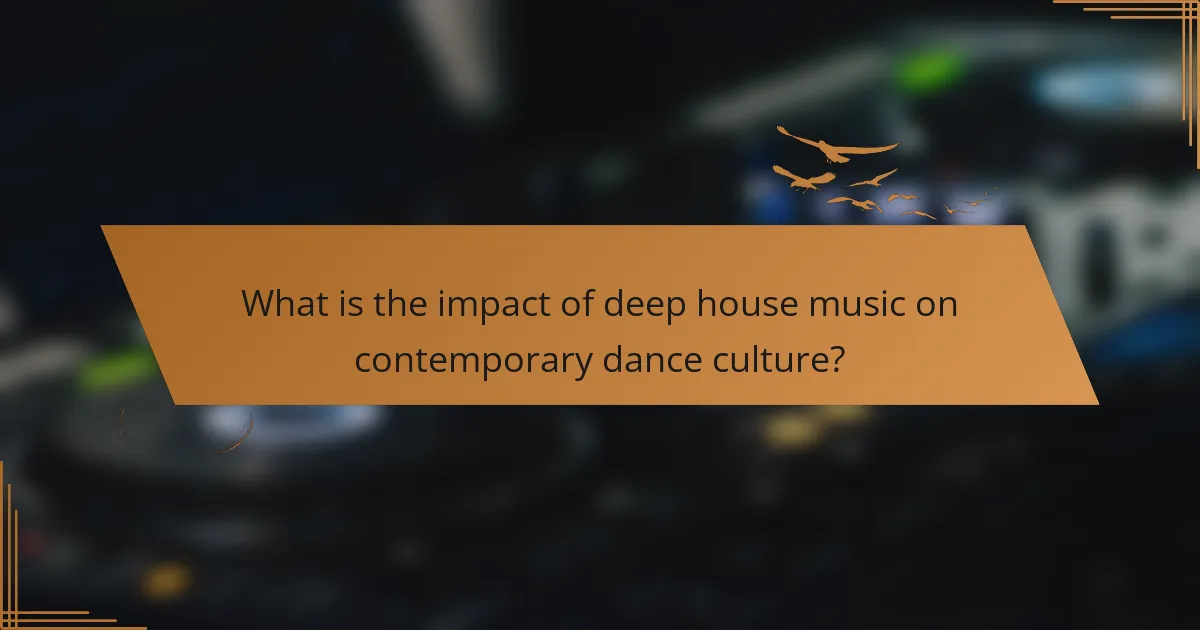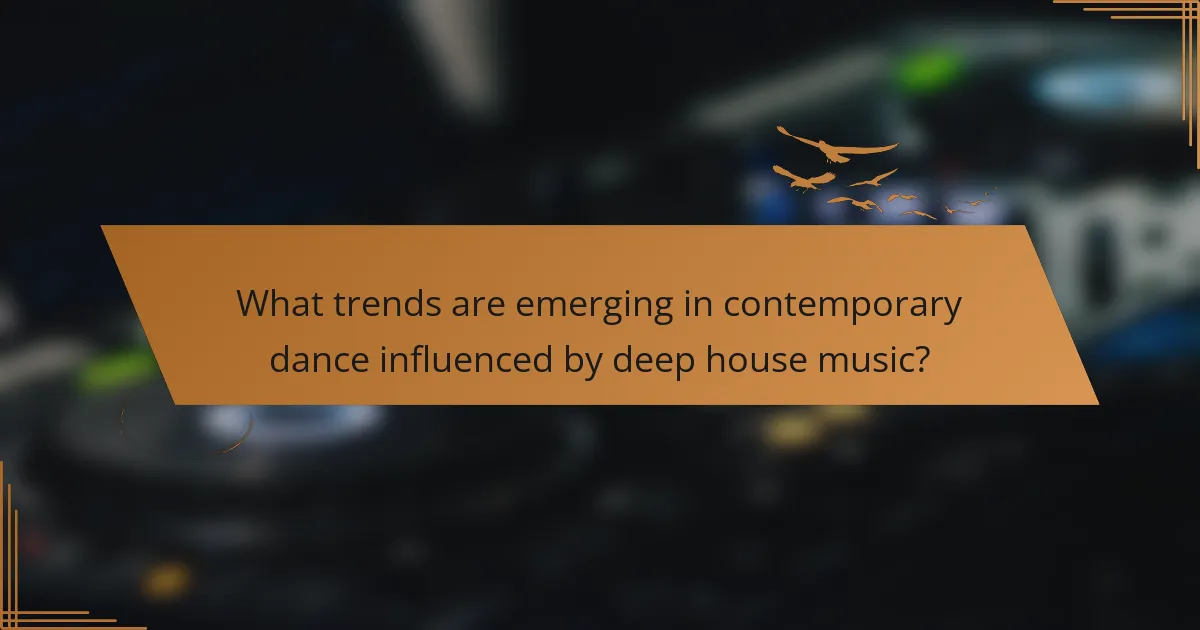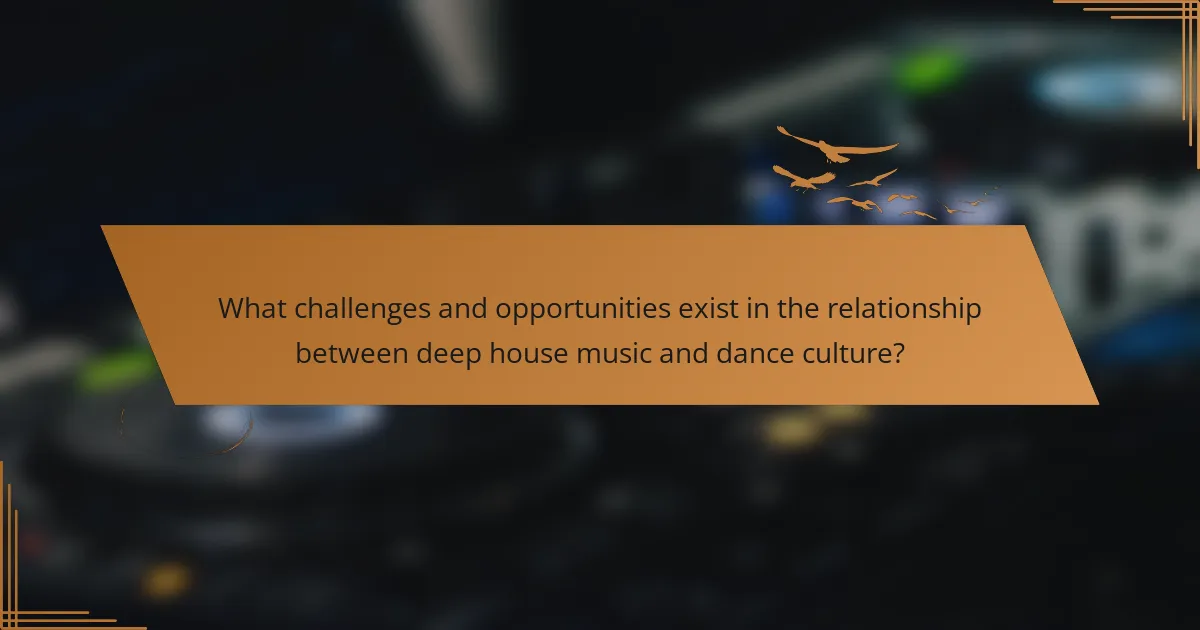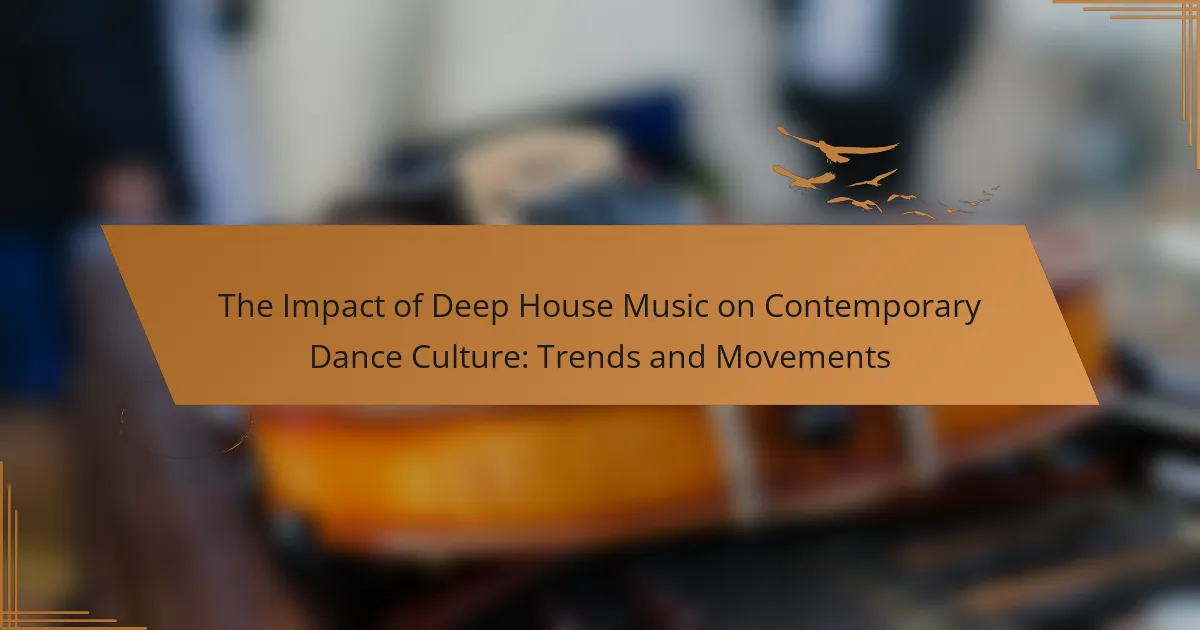Deep house music is a genre that significantly influences contemporary dance culture through its smooth and soulful sound, fostering expressive movement and a strong connection between dancers and music. Originating in the 1980s and 1990s, deep house has integrated into various dance forms, inspiring emotional expression and creativity among dancers. The article explores emerging trends in dance influenced by deep house, such as fluid movement styles and improvisation, while also addressing challenges like oversaturation and commercialization. Furthermore, it highlights opportunities for collaboration across genres and the role of technology in enhancing dance performances, emphasizing the evolving relationship between music and movement in contemporary culture.

What is the impact of deep house music on contemporary dance culture?
Deep house music significantly influences contemporary dance culture. Its smooth, soulful sound encourages expressive and fluid dance movements. The genre’s emphasis on rhythm and groove fosters a strong connection between dancers and the music. Deep house is often featured in clubs, festivals, and dance studios, shaping the styles and techniques of contemporary dance.
The genre’s origins in the 1980s and 1990s have led to its integration into various dance forms, including jazz and modern dance. Dancers often cite deep house tracks for their ability to evoke emotions and inspire creativity. The genre’s popularity has also led to the creation of dance challenges and social media trends, further embedding it in contemporary culture.
Research indicates that deep house music enhances mood and energy levels, which can improve dance performance. The genre’s unique soundscapes encourage improvisation, allowing dancers to explore personal expression. Overall, deep house music plays a crucial role in shaping the evolution of contemporary dance culture.
How has deep house music influenced dance styles in modern culture?
Deep house music has significantly influenced dance styles in modern culture. This genre promotes a relaxed yet rhythmic vibe, encouraging fluid and expressive movements. Dancers often incorporate elements of freestyle, allowing for personal expression. The genre’s emphasis on groove has led to the popularity of styles like house dance and waacking. House dance, in particular, emerged in the 1980s, drawing from deep house’s melodic and soulful elements. Events and festivals featuring deep house music often showcase diverse dance interpretations. This has fostered a community that values creativity and innovation in dance. The cultural impact is evident in dance studios and social dance scenes worldwide.
What are the key characteristics of deep house music that affect dance?
Deep house music is characterized by its smooth, soulful sound and steady rhythm, which significantly influences dance. The genre typically features a tempo ranging from 120 to 125 BPM, promoting a relaxed yet engaging dance atmosphere. Its use of deep basslines creates a rich foundation, encouraging body movement and fluidity. Melodic elements often include jazzy chords and vocal samples, enhancing emotional expression in dance. The repetitive structure of deep house tracks allows dancers to immerse themselves in the groove. Additionally, the incorporation of atmospheric sounds creates a captivating environment that inspires creativity in movement. Overall, these characteristics foster a unique connection between the music and the dancer’s experience.
How do the rhythms of deep house music shape dance movements?
The rhythms of deep house music significantly influence dance movements. The genre features a steady four-on-the-floor beat, which creates a consistent pulse. This pulse encourages dancers to synchronize their movements with the music. The use of syncopation in deep house adds complexity, prompting varied and intricate dance styles. Additionally, deep house often incorporates smooth basslines, which inspire fluid, continuous movements. The atmospheric elements in deep house music can evoke emotional responses, affecting the expressiveness of dance. Research indicates that music tempo directly correlates with the speed and style of dance, reinforcing this relationship.
Why is deep house music significant in contemporary dance events?
Deep house music is significant in contemporary dance events due to its unique blend of rhythm and melody. This genre promotes a relaxed atmosphere that encourages extended dance sessions. Its steady beats and soulful vocals resonate with audiences, enhancing emotional connections. Deep house often features complex basslines, which create a rich auditory experience. This complexity allows for creative expression among dancers. Furthermore, deep house has roots in the Chicago house scene, giving it historical importance in electronic music. The genre’s evolution reflects broader cultural shifts in dance music. Consequently, deep house remains a staple in contemporary dance events, influencing both DJs and dancers alike.
What role does deep house music play in dance festivals and clubs?
Deep house music plays a significant role in dance festivals and clubs by creating an immersive atmosphere. Its smooth, melodic sound encourages relaxation and deep emotional connection among listeners. This genre often features intricate rhythms and soulful vocals, which enhance the overall experience of attendees.
At dance festivals, deep house music is frequently played during sunset and nighttime sets, contributing to a euphoric vibe. Clubs often utilize deep house tracks to maintain a steady groove that keeps dancers engaged for extended periods. This genre attracts a diverse audience, fostering a sense of community and shared enjoyment.
Moreover, deep house music has influenced various dance styles, encouraging expressive movement and creativity on the dance floor. Its popularity has led to collaborations with artists across genres, further solidifying its presence in contemporary dance culture. The consistent presence of deep house music in these settings highlights its importance in shaping the atmosphere and experience of dance events.
How does deep house music contribute to the atmosphere of dance gatherings?
Deep house music contributes to the atmosphere of dance gatherings by creating a relaxed yet energetic environment. Its smooth melodies and deep basslines encourage movement and connection among dancers. The genre’s tempo, typically ranging from 120 to 125 BPM, facilitates a steady groove that invites prolonged dancing. Additionally, deep house often incorporates soulful vocals and atmospheric sounds, enhancing emotional engagement. This emotional depth fosters a sense of community among attendees. Events featuring deep house music frequently attract diverse crowds, promoting inclusivity. The genre’s roots in Chicago house music give it historical significance in dance culture. Overall, deep house music plays a crucial role in shaping the vibe of dance gatherings.

What trends are emerging in contemporary dance influenced by deep house music?
Emerging trends in contemporary dance influenced by deep house music include fluid movement styles and improvisational techniques. Dancers are increasingly incorporating elements of freestyle and personal expression. This trend emphasizes emotional connection to the music’s rhythm and beats. Choreographers are blending traditional dance forms with deep house influences. Collaborations between DJs and dancers are becoming more common in performances. The use of technology, such as visual projections and lighting, enhances the immersive experience. Additionally, community-driven events and workshops are fostering creativity and collaboration among dancers. These trends reflect the evolving relationship between music and movement in contemporary dance.
How are choreographers incorporating deep house music into their routines?
Choreographers are incorporating deep house music into their routines by utilizing its rhythmic beats and melodic structures. They design movements that align with the steady tempo of deep house tracks. This genre’s smooth transitions complement fluid dance styles, enhancing performance aesthetics. Choreographers often emphasize improvisation, allowing dancers to respond organically to the music’s vibe. Workshops and classes increasingly feature deep house tracks to inspire creativity. Notably, performances at festivals showcase the synergy between deep house music and contemporary dance. The genre’s emotional depth encourages expressive movement, fostering a deeper connection with the audience.
What innovative dance techniques are being developed in response to deep house music?
Innovative dance techniques being developed in response to deep house music include fluid body movements and improvisational styles. These techniques emphasize organic flow and connection to the music’s rhythm. Dancers often incorporate elements from styles like contemporary and jazz. The use of isolation and body waves is also prominent. Many dancers focus on expressing emotional depth through their movements. Workshops and classes are emerging to teach these techniques. Influential choreographers are blending traditional forms with modern interpretations. These developments reflect deep house music’s influence on dance culture.
How do dancers interpret deep house music in their performances?
Dancers interpret deep house music in their performances through expressive movements and rhythmic synchronization. The smooth, melodic elements of deep house inspire fluid and often improvisational dance styles. Dancers often embody the music’s emotional depth, creating a connection between the sound and their physical expression. The repetitive beats in deep house allow for extended dance sequences, encouraging prolonged engagement with the music. Many dancers utilize techniques from styles like house dance and contemporary to enhance their performances. This blend of styles reflects the genre’s roots in both club culture and artistic expression. Research indicates that deep house music fosters a sense of community among dancers, enhancing the overall experience of the performance. The music’s laid-back tempo often leads to a focus on individual interpretation, allowing dancers to showcase their unique styles.
What cultural movements are associated with deep house music and dance?
Deep house music and dance are associated with several cultural movements. The Chicago house movement in the 1980s laid the groundwork for deep house. This movement emphasized soulful vocals and jazzy elements. The Detroit techno scene also influenced deep house, merging electronic sounds with emotive themes.
The rave culture of the late 1980s and early 1990s embraced deep house in underground parties. This culture promoted freedom of expression and community. Additionally, the [censured] movement has a significant connection to deep house. Many clubs that feature deep house music are safe spaces for [censured] individuals.
The global expansion of deep house has led to diverse cultural influences. Various regions have infused their local sounds into the genre. This has resulted in a rich tapestry of musical styles within deep house. Overall, deep house music and dance reflect a blend of cultural movements focused on inclusivity and artistic expression.
How does deep house music reflect social and cultural changes in dance?
Deep house music reflects social and cultural changes in dance by promoting inclusivity and diversity. This genre emerged in the 1980s, blending elements of Chicago house and jazz. It emphasizes a slower tempo, allowing for more expressive movement styles. The music often features soulful vocals, which resonate with various cultural backgrounds. As a result, deep house fosters a sense of community on the dance floor.
The rise of deep house correlates with the acceptance of varied dance styles, from contemporary to street dance. Events and festivals featuring deep house attract diverse audiences. This reflects broader societal shifts towards acceptance and celebration of different cultures. The genre’s popularity in urban areas showcases its role in social movements.
Deep house music has also influenced dance trends, encouraging improvisation and personal expression. This shift mirrors a growing desire for authenticity in artistic expression. Overall, deep house serves as a soundtrack for evolving social dynamics in dance culture.
What communities are forming around deep house and contemporary dance?
Communities forming around deep house and contemporary dance include local dance collectives, online forums, and social media groups. These communities often focus on sharing music, dance styles, and event information. Local collectives organize workshops and dance events that promote deep house music. Online forums provide a platform for discussions on techniques and trends in contemporary dance. Social media groups facilitate connections among enthusiasts globally. Events like festivals and club nights further strengthen these communities. Participation in these spaces fosters collaboration and creativity. These communities are crucial for the evolution of dance styles influenced by deep house music.

What challenges and opportunities exist in the relationship between deep house music and dance culture?
Deep house music faces challenges and opportunities within dance culture. One challenge is the oversaturation of the genre, leading to a diluted sound and reduced innovation. This can cause audience fatigue and hinder the genre’s growth. Additionally, commercialization may compromise the authenticity of deep house music, alienating core fans.
Conversely, deep house music presents opportunities for collaboration with other genres, fostering creativity and attracting diverse audiences. The rise of social media platforms allows artists to reach global listeners, expanding their fan base. Events and festivals dedicated to deep house create communal experiences, strengthening the connection between music and dance culture.
The evolution of technology also enables new forms of expression in dance, enhancing performances. Overall, while challenges exist, the potential for growth and innovation remains significant within the relationship between deep house music and dance culture.
What obstacles do dancers face when performing to deep house music?
Dancers face several obstacles when performing to deep house music. The tempo of deep house music typically ranges from 120 to 125 beats per minute. This can challenge dancers’ timing and rhythm. The repetitive nature of the music may lead to fatigue during extended performances. Additionally, deep house often features subtle variations in beat, which can cause synchronization issues among dancers. The atmospheric quality of the music may also require dancers to adapt their emotional expression, complicating their performance. Finally, the often minimalistic production can limit the dynamic range of movement, affecting choreography.
How do venue acoustics impact the experience of dancing to deep house music?
Venue acoustics significantly influence the experience of dancing to deep house music. Acoustics determine how sound waves interact within a space. This affects clarity, volume, and overall sound quality. Good acoustics enhance the bass frequencies, which are crucial in deep house music. Bass frequencies create a physical sensation that encourages movement. Poor acoustics can lead to muddled sound, making it difficult to enjoy the music. Studies show that ideal reverberation times enhance listener engagement. In contrast, excessive echo can disrupt the rhythm and flow of dancing. Overall, effective venue acoustics create an immersive experience that enhances enjoyment and encourages dancing.
What are common misconceptions about deep house music in dance culture?
Common misconceptions about deep house music include the belief that it is merely a subgenre of house music. In reality, deep house has distinct characteristics, such as its use of complex melodies and atmospheric sounds. Another misconception is that deep house lacks energy. Many tracks are designed for dancing and have a strong rhythmic foundation. Some people think deep house is only for niche audiences. However, it has gained mainstream popularity and influences various genres. Additionally, there is a belief that deep house is always slow-paced. Many deep house tracks have upbeat tempos suitable for clubs and festivals. Misunderstanding the emotional depth of deep house is also common. The genre often conveys rich emotions, unlike perceptions of it being monotonous. These misconceptions can limit appreciation for deep house’s contribution to contemporary dance culture.
What best practices can dancers adopt when engaging with deep house music?
Dancers should focus on rhythm and groove when engaging with deep house music. This genre emphasizes a strong, steady beat that dancers can use to enhance their movements. Understanding the structure of deep house tracks, including breakdowns and builds, is essential for timing. Dancers should also experiment with fluid and organic movements to match the smooth sound of deep house. Incorporating improvisation allows for personal expression within the music’s framework. Collaborating with other dancers can enhance the experience and create dynamic performances. Practicing regularly helps in developing muscle memory for intricate footwork and body movements. Engaging with the community through workshops and classes fosters growth and connection. These practices are supported by the genre’s emphasis on creativity and connection to the music.
How can dancers effectively prepare for performances using deep house tracks?
Dancers can effectively prepare for performances using deep house tracks by selecting music that aligns with their choreography. The tempo of deep house music typically ranges from 120 to 125 beats per minute, which is suitable for various dance styles. Dancers should listen to the track repeatedly to internalize the rhythm and structure. This helps them synchronize their movements with the music.
Practicing specific sequences to deep house tracks enhances muscle memory. Dancers can also focus on the emotional quality of the music to express feelings through their performance. Additionally, deep house often features repetitive beats, allowing dancers to build stamina and confidence during practice.
Research shows that music with a steady beat aids in movement coordination (Thaut, 2005). This supports the idea that deep house tracks can improve a dancer’s timing and flow. By incorporating these strategies, dancers can enhance their overall performance quality.
What resources are available for dancers to learn about deep house music and its influence?
Dancers can learn about deep house music and its influence through various resources. Online platforms such as YouTube offer tutorials and documentaries that explore the genre. Websites like Resident Advisor provide articles and interviews with influential artists. Music streaming services like Spotify curate playlists that highlight deep house tracks. Dance studios often host workshops focused on deep house styles. Social media groups and forums connect dancers to discussions about the genre. Books such as “The History of House Music” provide in-depth insights. Educational institutions may offer courses on electronic music and its cultural impact. These resources collectively enhance understanding of deep house music’s role in dance culture.
The main entity of this article is deep house music and its impact on contemporary dance culture. The article explores how deep house music influences dance styles, enhances emotional expression, and fosters community among dancers. Key characteristics of deep house, such as its rhythmic structure and melodic elements, are discussed in relation to their effects on dance movements. Emerging trends, innovative techniques, and the significance of deep house in dance events are also examined, along with the challenges and opportunities present in this evolving cultural landscape. Overall, the article provides a comprehensive overview of the interplay between deep house music and contemporary dance.
